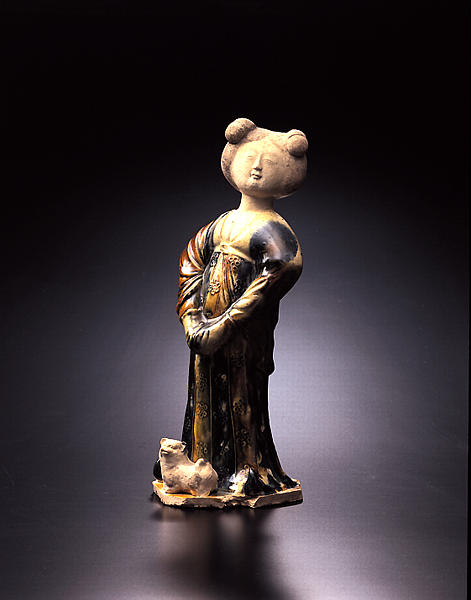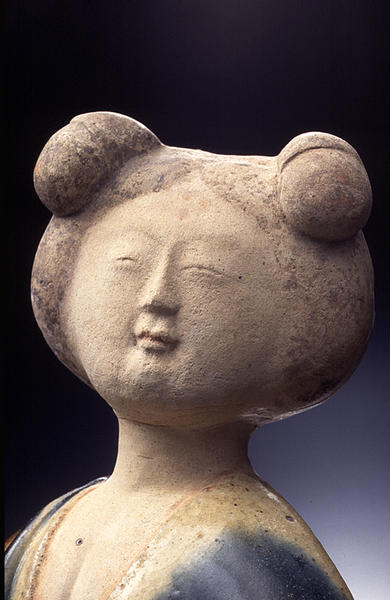犬と立女俑
- 中国
- 中国・唐時代
- 8世紀前期
- 三彩
- H-29
唐三彩は7世紀の後半に始まり、おもに盛唐時代(684-756)を中心に明器として造られ、安史の乱あたりで混乱、次第に衰退して行ったと考えられている。この俑とよく似た作品には、1954年に西安市東郊王家墳11号墓から出土した三彩女坐俑のほか、数点が認められる。いずれも作風、服制、大きさもほぼ等しい。西安東郊王家墳90号墓から出土した華麗な女子椅坐俑(高47.3cm)などよりは少し後、8世紀初頭の作と考えられる。
Catalogue Entry
Perhaps one of the best known images of a dog during the Tang period was painted by the well-known artist Zhou Fang, who specialized in scenes of court women and their activities.1 Ceramic images of court women with dogs, like this example, were also created for tombs.
The figure leans slightly to the left, and her full jacket sleeves conceal her lowered hands. A small dog, painted with black dots, is attentively gazing at its mistress. The woman's attire is similar in style and glaze to that of the pair of figures in the preceding entry (cat. no. 128), however this ceramic skirt ensemble has been embellished with rosette designs in relief. The rosette motif was introduced into China from the West and was especially popular during the Tang dynasty.2 Indeed, a section of an actual skirt dating from this period and printed with similar rosette motifs was unearthed from Turfan in Xinjiang province.3
This tomb figure's hair has been fashioned into a "twin-fork bun," an especially popular hairstyle among young unmarried Tang women.4 Her face and neck are unglazed, but details of eyes, eyebrows, and hair have all been painted black. Cinnabar red colors the maid's lips as well as the V-shaped edge of her jacket neckline. A light red color, imitating rouge, accents the tomb figure's cheeks. Rouge, made from wild safflowers that grew in abundance in the Western Regions, was transported to the Tang capital via the Silk Route.5 Red also colors the flower motif which appears between the tomb figure's eyebrows. This particular facial decoration is believed to have evolved during the Six dynasties period (A.D. 220-589). According to legend, a plum flower accidentally fell onto the forehead of a sleeping princess and dyed it to such an extent that when she awoke, the design could not be erased. Inspired by this story, soon other court women started to imitate this fashion.6
Although extant female tomb figures with dogs are rare, there is one in the collection of the Museum of Oriental Ceramics in Osaka. A seated, three-color female tomb figure, featuring a similarly patterned skirt but sporting a different hairdo, was unearthed at grave 11 of Wang family tomb located near Xi'an.7 Finally, a painting of a maid also wearing a skirt with rosette motifs in featured on a wall found in Prince Zhanghuai's tomb in Shaanxi province which is dated 711.8
HK
1. Shen 1981, p. 230, pl. 24.
2. Segraves 1996a, pp. 54-62.
3. Gao and Sun 1988,p248, pl. 343.
4. He, Zhang, and Guo 1987, p. 57.
5. Zhou and Gao 1987, p. 86.
6. Ibid.
7. Mizuno 1979, fig 3.
8. Tang 1994, p. 88, fig 53.

